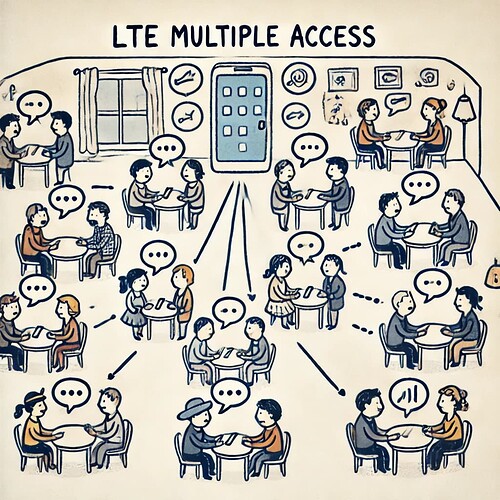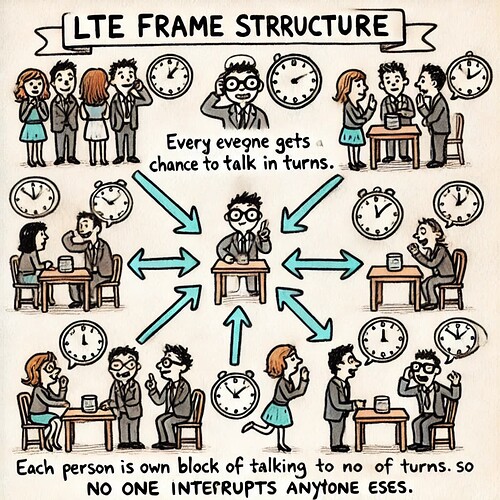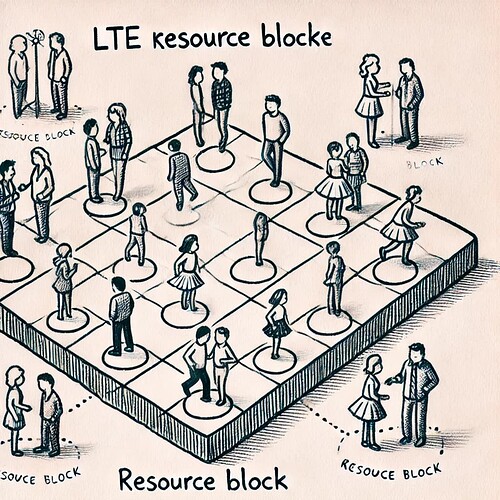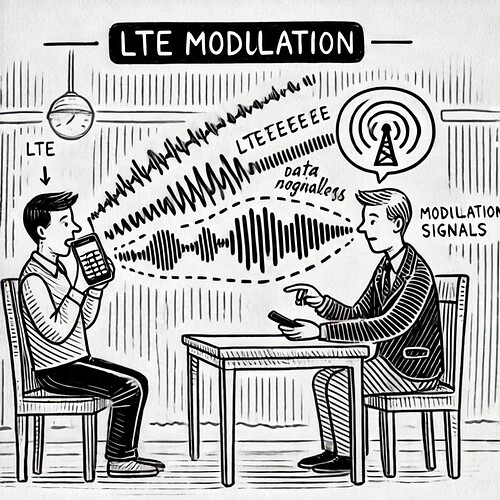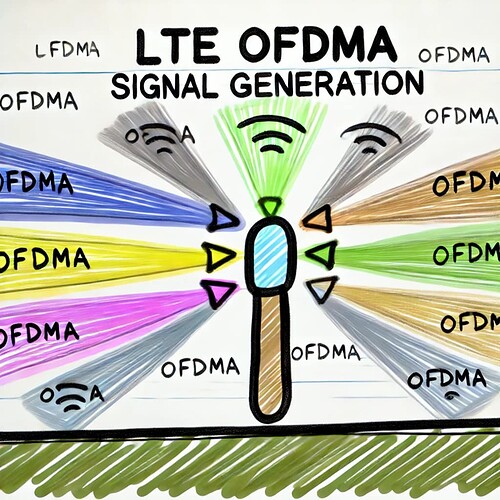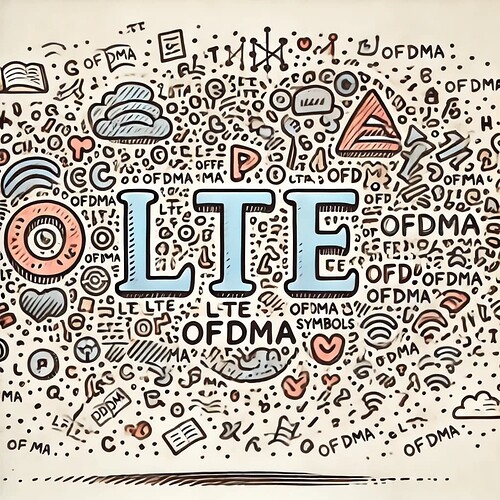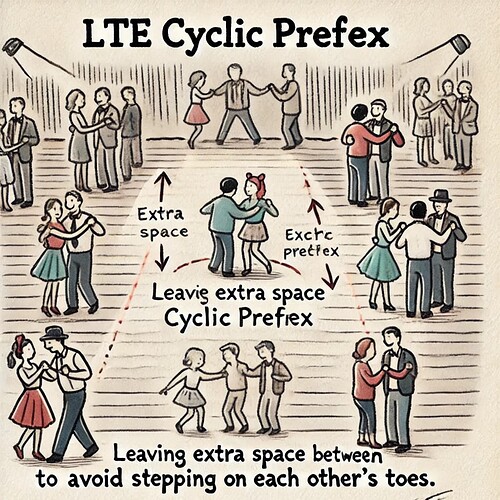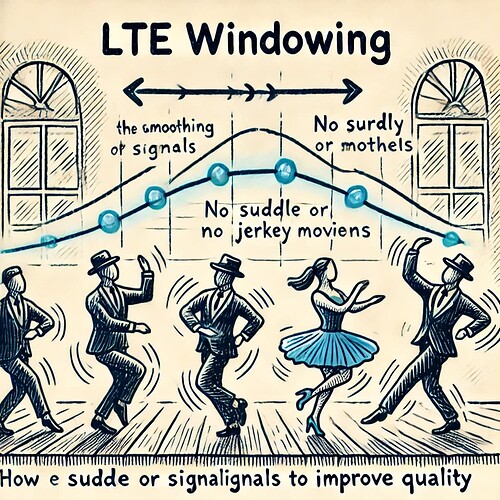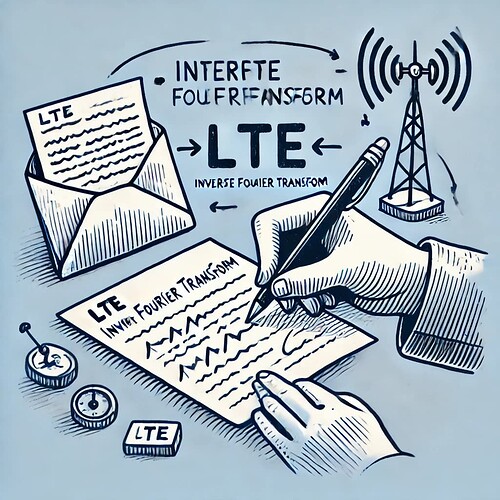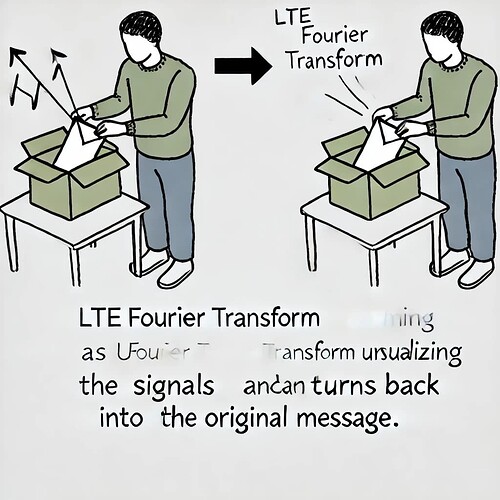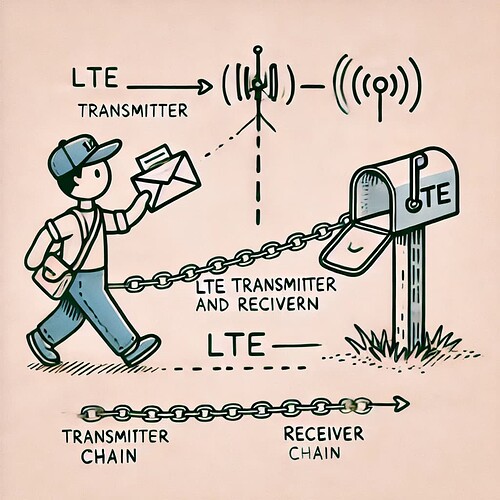This topic presents in a very simplified way all the main concepts that should be understood by those who know LTE.
LTE Downlink Air-Interface
Skip to: Roadmap to LTE
- Multiple Access
- Frame Structure
- Resource Blocks
- Modulation
- OFDMA Signal Generation
- OFDMA Symbol
- Cyclic Prefix
- Windowing
- Inverse Fourier Transform
- Fourier Transform
- Transmitter and Receiver Chain
Multiple Access
A method that allows many users to connect to the network simultaneously, sharing the same resources without interference.
![]() Think of this as a party where lots of people (users) are talking at once. Everyone needs to share the room (network) without shouting over each other, so they each get their own space to talk.
Think of this as a party where lots of people (users) are talking at once. Everyone needs to share the room (network) without shouting over each other, so they each get their own space to talk.
- Search Forum
 LTE Multiple Access
LTE Multiple Access 
Frame Structure
The way data is organized and divided into smaller time units (frames) for transmission.
![]() Now, at the party, we organize the conversation into little blocks of time, so no one talks over anyone else. The frame structure divides the time so everyone gets a chance to speak.
Now, at the party, we organize the conversation into little blocks of time, so no one talks over anyone else. The frame structure divides the time so everyone gets a chance to speak.
- Search Forum
 LTE Frame Structure
LTE Frame Structure 
Resource Blocks
The basic units of frequency and time in the LTE network, used to carry data for transmission.
![]() These are like tiny spaces on the dance floor (network) where people can move. Each person (user) gets their own space, called a resource block, to move (send their data).
These are like tiny spaces on the dance floor (network) where people can move. Each person (user) gets their own space, called a resource block, to move (send their data).
- Search Forum
 LTE Resource Blocks
LTE Resource Blocks 
Modulation
A process that changes data into signals that can be sent through the air by varying frequency, amplitude, or phase.
![]() This is how we turn messages into signals that can travel. It’s like turning your voice into waves that can be heard across the room. In LTE, we change these signals so they can travel through the air to your phone.
This is how we turn messages into signals that can travel. It’s like turning your voice into waves that can be heard across the room. In LTE, we change these signals so they can travel through the air to your phone.
- Search Forum
 LTE Modulation
LTE Modulation 
OFDMA Signal Generation
A technique that splits data into smaller parts and transmits them over different frequencies, improving efficiency and reducing interference.
![]() Imagine sending several messages at once using different colors of light. Each color (frequency) carries a piece of the message, making it faster. That’s what OFDMA does - sends data on different channels all at the same time.
Imagine sending several messages at once using different colors of light. Each color (frequency) carries a piece of the message, making it faster. That’s what OFDMA does - sends data on different channels all at the same time.
- Search Forum
 LTE OFDMA Signal Generation
LTE OFDMA Signal Generation 
OFDMA Symbol
A small piece of data that is transmitted using OFDMA, representing a portion of the information being sent.
![]() Each tiny piece of the message is called an OFDMA symbol. It’s like a single letter in a word, and when you put all the symbols together, you get the complete message.
Each tiny piece of the message is called an OFDMA symbol. It’s like a single letter in a word, and when you put all the symbols together, you get the complete message.
Cyclic Prefix
A buffer added to each OFDMA symbol to prevent interference between them and ensure clean signal transmission.
![]() To keep the messages from bumping into each other, we add a little buffer at the start of each message, called a cyclic prefix. It’s like leaving extra space between people dancing so they don’t step on each other’s toes.
To keep the messages from bumping into each other, we add a little buffer at the start of each message, called a cyclic prefix. It’s like leaving extra space between people dancing so they don’t step on each other’s toes.
Windowing
A method used to smooth out the edges of signals to improve their quality and reduce distortion. Transmitted signal may be discontinuous at the boundary between two OFDMA symbols, generating spectrum emissions outside the channel bandwidth
![]() This is smoothing the edges of the messages, like making sure everyone’s movements on the dance floor are smooth, so nothing looks too sudden or jerky.
This is smoothing the edges of the messages, like making sure everyone’s movements on the dance floor are smooth, so nothing looks too sudden or jerky.
Inverse Fourier Transform
A mathematical operation that converts signals from the frequency domain back to the time domain for transmission.
![]() Before we send the messages, we need to prepare them. It’s like writing a letter before you send it in the mail. The inverse Fourier transform is the step where we prepare the message to be sent.
Before we send the messages, we need to prepare them. It’s like writing a letter before you send it in the mail. The inverse Fourier transform is the step where we prepare the message to be sent.
Fourier Transform
A mathematical process that transforms signals from the time domain back into the frequency domain for analysis at the receiver.
![]() Once the message is received, we need to unpack it so we can understand it. That’s what the Fourier transform does - it takes the signals and turns them back into the original message.
Once the message is received, we need to unpack it so we can understand it. That’s what the Fourier transform does - it takes the signals and turns them back into the original message.
Transmitter and Receiver Chain
The entire process and equipment used to send and receive signals between the cell tower and the device.
![]() Finally, we have the tools that make all this happen. The transmitter is like the mailman who delivers the message, and the receiver is like the mailbox that collects it on the other end. Together, they make sure the message gets from the sender to the receiver smoothly.
Finally, we have the tools that make all this happen. The transmitter is like the mailman who delivers the message, and the receiver is like the mailbox that collects it on the other end. Together, they make sure the message gets from the sender to the receiver smoothly.
That’s it. ![]()
-
Continue reading: Roadmap to LTE - Downlink Multiple Antenna Technologies
-
Or back to: Roadmap to LTE
